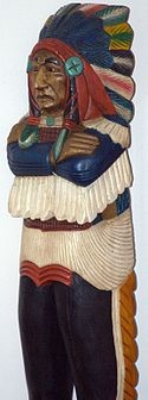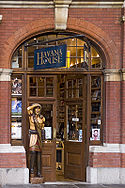
Cigar store Indian
Encyclopedia

Indigenous peoples of the Americas
The indigenous peoples of the Americas are the pre-Columbian inhabitants of North and South America, their descendants and other ethnic groups who are identified with those peoples. Indigenous peoples are known in Canada as Aboriginal peoples, and in the United States as Native Americans...
, made to represent tobacconist
Tobacconist
A tobacconist is an expert dealer in tobacco in various forms and the related accoutrements .Such accoutrements include pipes, lighters, matches, pipe cleaners, pipe tampers, ashtrays, humidification devices, hygrometers, humidors, cigar cutters, and more. Books and magazines, especially ones...
s, much like: barber poles advertise barber
Barber
A barber is someone whose occupation is to cut any type of hair, and to shave or trim the beards of men. The place of work of a barber is generally called a barbershop....
shops; Show globe
Show globe
A show globe is a glass vessel of various shapes and sizes containing a colorful liquid. It has been a symbol of pharmacy from the 17th century England to the early 20th century in the United States. It marked the drugstore or apothecary in much the same way as the barber's pole marked tonsorial...
for an apothecary
Apothecary
Apothecary is a historical name for a medical professional who formulates and dispenses materia medica to physicians, surgeons and patients — a role now served by a pharmacist and some caregivers....
; or the three gold balls of the pawn shop. The figures are often three-dimensional wooden sculptures several feet tall – up to life-sized. They are still occasionally used for their original advertising purpose but are more often seen as decorations or advertising collectibles.
History
Because of the general illiteracy of the populace, early store owners used descriptive emblems or figures to advertise their shops' wares. American Indians and tobaccoTobacco
Tobacco is an agricultural product processed from the leaves of plants in the genus Nicotiana. It can be consumed, used as a pesticide and, in the form of nicotine tartrate, used in some medicines...
had always been associated because American Indians introduced tobacco to Europeans, and the depiction of native people on smoke-shop signs was almost inevitable. As early as the seventeenth century, European tobacconists used figures of American Indians to advertise their shops. Because European carvers had never seen a Native American, these early cigar-store "Indians" looked more like black slaves with feathered headdresses and other fanciful, exotic features. These carvings were called "Black Boys" or "Virginians" in the trade. Eventually, the European cigar-store figure began to take on a more "authentic" yet highly stylized native visage, and by the time the smoke-shop figure arrived in the Americas in the late eighteenth century, it had become thoroughly "Indian."

Today
The cigar store Indian became less common in the 20th century for a variety of reasons. New sidewalk-obstruction laws, higher manufacturing costs, restrictions on tobacco advertising, and increased racial sensitivity relegated the figures to museums and antique shops. To some, the cigar store Indian is considered the native equivalent of the black lawn jockeyLawn jockey
A lawn jockey is a small statue of a man in jockey clothes, intended to be placed in yards. Most today are white jockeys, but historically black jockeys were commonplace...
—a stereotypical portrayal of Native Americans; however, cigar store Indians are still made for sale and can be found outside cigar stores. One example of the meme
Meme
A meme is "an idea, behaviour or style that spreads from person to person within a culture."A meme acts as a unit for carrying cultural ideas, symbols or practices, which can be transmitted from one mind to another through writing, speech, gestures, rituals or other imitable phenomena...
still in current use is the Natural American Spirit
Natural American Spirit
Natural American Spirit is a brand of cigarette and tobacco products manufactured in the United States by the Santa Fe Natural Tobacco Company, a wholly owned independent subsidiary of Reynolds American, in turn 42% owned by British American Tobacco...
tobacco company's stylized image of a Native American smoking a peace pipe as its brand logo
Logo
A logo is a graphic mark or emblem commonly used by commercial enterprises, organizations and even individuals to aid and promote instant public recognition...
.

